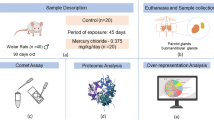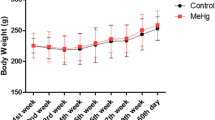Abstract
Amalgam is still one of the most frequently used dental filling materials. However, the possible adverse effects especially that of the mercuric component have led to continued controversy. Considering that mercury may be released from amalgam fillings into the oral cavity and also reach the circulating blood after absorption and resorption, it eventually may contribute to tumorigenesis in a variety of target cells. The present investigation focuses on genotoxic effects below a cytotoxic dose level of mercuric dichloride (HgCl2) in human samples of salivary glands and lymphocytes to elucidate a possible role in tumor initiation. DNA migration due to single strand breaks, alkali labile sites and incomplete excision repair was quantified with the aid of the single cell microgel electrophoresis (Comet) assay. The concepts of Olive Tail Moment, percentage of DNA in the Tail and Tail Length were used as measures of DNA damage. To control for cytotoxic effects, the trypan blue exclusion test was applied. Human samples of the parotid salivary gland and lymphocytes of ten donors were exposed to HgCl2 concentrations from 1 to 50 μM. N-methyl-N′-nitro-N-nitrosoguanidine (MNNG) and dimethyl sulfoxide (DMSO) served as controls. Increasing dose-dependent DNA migration could be demonstrated after exposure to HgCl2 in cells of the salivary glands and lymphocytes. In both cell types a significant increase in DNA migration could be shown starting from HgCl2 concentrations of 5 μM in comparison to the negative control. The viability of the cell systems was not affected except at the highest concentration (50 μM) tested. These data indicate genotoxic effects of mercuric dichloride in human salivary glands and lymphocytes at concentrations not leading to cytotoxic effects or cell death. Consequently, a contributory role in oral salivary gland tumor initiation warrants further investigation.


Similar content being viewed by others
References
Albertini RJ, Anderson D, Douglas GR, Hagmar L, Hemminki K, Merlo F, Natarajan AT, Norppa H, Shuker DEG, Tice R, Waters MD, Aitio A (2000) IPCS guidelines for the monitoring of genotoxic effects of carcinogens in humans. Mutat Res 463:111–172
Ascani G, Pieramici T, Messi M, Lupi E, Rubini C, Balercia P (2006) Salivary gland tumors: a retrospective study of 454 patients. Minerva Stomatol 55:209–214
Bahia O, De Amorim MI, Burbano RR, Vincent S, Dubeau H (1999) Genotoxic effects of mercury on in vitro cultures of human cells. An Acad Bras Cienc 71:437–443
Bloching M, Grummt T, Reich W (2005) Genotoxikologische Prüfverfahren zum Nachweis des Einflusses der Mundgesundheit auf die Entstehung von Plattenepithelkarzinomen im oberen Aerodigestivtrakt. HNO-Informationen 84:146
Clarkson TW (2002) The three modern faces of mercury. Environ Health Perspect 110:11–23
Clarkson TW, Magos L, Myers GJ (2003) The toxicology of mercury-current exposures and clinical manifestations. N Engl J Med 349:1731–1737
Collins AR (2004) The Comet Assay for DNA Damage and Repair: Principles, Applications and Limitations. Mol Biotechnol 26:249–261
Cotelle S, Ferard JF (1999) Comet assay in genetic ecogenotoxicology: a review. Environ Mol Mutagen 34:246–255
Davies L, Welch HG (2006) Epidemiology of head and neck cancer in the United States. Otolaryngol Head Neck Surg 135:451–457
De Flora S, Bennicelli C, Bagnasco M (1994) Genotoxicity of mercury compounds. A review. Mutat Res 317:57–79
Dunsche A, Kastel I, Terheyden H, Springer IN, Christophers E, Brasch J (2003) Oral lichenoid reactions associated with amalgam: improvement after amalgam removal. Br J Dermatol 148:70–76
Ganss C, Gottwald B, Traenckner I, Kupfer J, Eis D, Mönch J, Gieler U, Klimek J (2000) Relation between mercury concentrations in saliva, blood and urine in subjects with amalgam restaurations. Clin Oral Invest 4:206–211
Gopal KV (2003) Neurotoxic effects of mercury on auditory cortex networks growing on microelectrode arrays: a preliminary analysis. Neurotoxicol Teratol 25:69–76
Grover P, Saleha Banu B, Dana Devi K, Begum S (2001) In vivo genotoxic effects of mercuric chloride in rat peripheral blood leucocytes using comet assay. Toxicology 167:191–197
Halbach S, Kremers L, Willruth H, Mehl A, Welzl G, Wack FX, Hickel R, Greim H, (1998) Systemic transfer of mercury from amalgam fillings before and after cessation of emission. Environ Res 77:115–123
Halbach S, Welzl G, Kremers L, Willruth H, Mehl A, Wack FX, Hickel R, Greim H (2000) Steady-state transfer and depletion kinetics of mercury from amalgam fillings. Sci Total Environ 259:13–21
Harréus UA, Baumeister P, Wallner BC, Berghaus A, Kleinsasser NH (2005) Karzinogene und kokarzinogene Effekte von Metallen und Ethylalkohol in humanen Speicheldrüsenzellen. HNO 53:155–162
Henderson L, Wolfreys A, Fedyk J, Bourner C, Windebank S (1998) The ability of the Comet assay to discriminate between genotoxins and cytotoxins. Mutagenesis 13:89–95
Horn-Ross PL, Ljung BM, Morrow M (1997) Environmental factors and the risk of salivary gland cancer. Epidemiology 8:414–419
IARC (1997) Monographs on the evaluation of carcinogenic risks to humans. Beryllium, cadmium, mercury, and exposures in the glass manufacturing industry. WHO 58
Ionescu JG, Novotny J, Stejskal VD, Latsch A, Blaurock-Busch E, Eisenmann-Klein M (2006) Increased levels of transition metals in breast cancer tissue. Neuro Endocrinol Lett 27, E-pub ahead of print
Kehe K, Reichl FX, Durner J, Walther U, Hickel R, Forth W (2001) Cytotoxicity of dental composite components and mercury compounds in pulmonary cells. Biomaterials 22:317–322
Kim SH, Sharma RP (2004) Mercury induced apoptosis and necrosis in murine macrophages: role of calcium-induced reactive oxygen species and p38 mitogen-activated protein kinase signalling. Toxicol Appl Pharmacol 196:47–57
Kleinsasser NH, Wallner BC, Kastenbauer ER, Muenzenrieder RK, Harréus UA (2000) Comparing genotoxic sensitivities of peripheral lymphocytes and mucosa of the upper aerodigestive tract of human donors using the Comet assay. Mutat Res 467:21–30
Kleinsasser NH, Juchhoff J, Wallner BC, Bergner A, Harréus UA, Gamarra F, Buehrlen M, Huber RM, Rettenmeier AW (2004) The use of mini-organ cultures of human upper aerodigestive tract epithelia in ecogenotoxicology. Mutat Res 561:63–73
Little MC, Watson REB, Pemberton MN, Griffiths CEM, Thornhill MH (2001) Activation of oral keratinocytes by mercuric chloride: relevance to dental amalgam-induced oral lichenoid reactions. Br J Dermatol 144:1024–1032
Mackert JR, Berglund A (1997) Mercury exposure from dental amalgam fillings: absorbed dose and the potential for adverse health effects. Crit Rev Oral Biol Med 8:410–436
McKelvey-Martin VJ, Green MH, Schmezer P, Pool-Zobel BL, De Meo MP, Collins A (1993) The single cell electrophoreses assay: a European review. Mutat Res 288:47–63
Olive PL, Durand RE, Le Riche J, Olivotto IA, Jackson SM (1993) Gel electrophoresis of individual cells to quantify hypoxic fraction in human breast cancer. Cancer Res 53:733–736
Phillips HJ (1973) Dye exclusion test for cell viability. In: Kruse PF, Patterson MK (Eds) Tissue culture methods and applications. Academic, New York, pp 406–408
Rajaee-Behbahani N, Müller-Vogt U, Gliniorz R, Engelhardt E, Bartsch H, Schmezer P (1999) Effect of long-term cryopreservation on mutagen sensitivity and DNA repair capacity of peripheral human lymphocytes. J Cancer Res Clin Oncol 125:32
Rao MV, Chinoy NJ, Suthar MB, Rajvanshi MI (2001) Role of ascorbic acid on mercuric chloride-induced genotoxicity in human blood cultures. Toxicol In Vitro 15:649–654
Reichl FX, Walther UI, Durner J, Kehe K, Hickel R, Kunzelmann KH, Spahl W, Hume WR, Benschop H, Forth W (2001) Cytotoxicity of dental composite components and mercury compounds in lung cells. Dent Mater 17:95–101
Rojas E, Lopez MC, Valverde M (1999) Single cell electrophoreses assay: methodology and applications. J Chromatogr B Biomed Sci Appl 722:225–254
Schurz F, Sabater-Vilar M, Fink-Gremmele J (2000) Mutagenicity of mercury chloride and mechanisms of cellular defense: the role of metal-binding proteins. Mutagenesis 15:525–530
Tice RR, Agurell E, Anderson D, Burlinson B, Hartmann A, Kobayashi H, Miyamae Y, Rojas E, Ryu JC, Sasaki YF (2000) Single cell gel/comet assay: guidelines for in vitro and in vivo genetic toxicology testing. Environ Mol Mutag 35:206–221
Wallner BC, Harréus UA, Gamarra F, Sassen A, Kleinsasser NH (2005) Genotoxicity studies in mini-organ cultures of human nasal mucosa. HNO 53:1037–1046
Walther UI, Walther SC, Liebl B, Reichl FX, Kehe K, Nilius M, Hickel R (2002) Cytotoxicity of ingredients of various dental materials and related compounds in L2- and A549 cells. J Biomed Mater Res 63:643–649
Author information
Authors and Affiliations
Corresponding author
Additional information
The authors declare that there is no conflict of interest.
Rights and permissions
About this article
Cite this article
Schmid, K., Sassen, A., Staudenmaier, R. et al. Mercuric dichloride induces DNA damage in human salivary gland tissue cells and lymphocytes. Arch Toxicol 81, 759–767 (2007). https://doi.org/10.1007/s00204-007-0208-3
Received:
Accepted:
Published:
Issue Date:
DOI: https://doi.org/10.1007/s00204-007-0208-3




